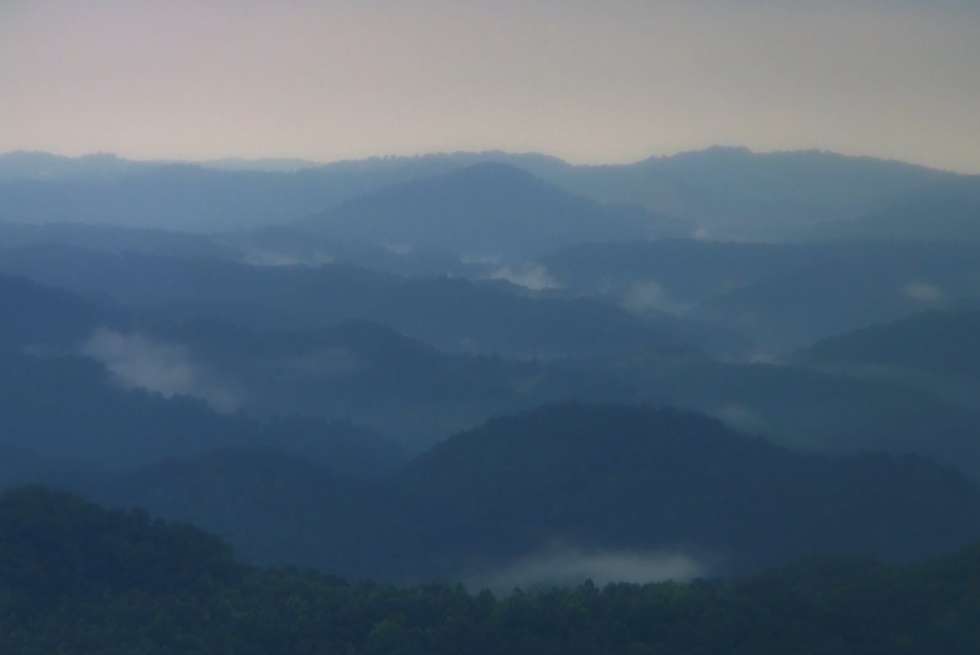
Sound precedes most imagery and all meaning: it causes trajectories and orientations to rebound, as though its resonance and timbre mark affective and atmospheric lines of force. Jeff Silva and Vic Rawlings’s Linefork (2016) charts such sonic registers, oscillating between everyday minutiae, precisely timed musical performances, and the virtually endless landscapes of the southern United States. Placid and serene, the film attunes itself to Opal and Lee Sexton, a retired couple from a mountain town in southeastern Kentucky. The film’s sympathetic and elegant observational film techniques embrace the intimate, precarious, and haptic, foregrounding the Sextons’ routines and skillful practices.

Linefork unfolds as a series of recognizable scenes: picking and peeling green beans, sharpening a kitchen knife, tuning a banjo, watching reality TV, counting bills for the smallest of purchases. Nothing really happens and things hardly add up, yet these tranquil and seemingly aimless sequences give form to emphatic pressures and forces within the frame: what appears to be a cupboard reveals itself as yet another cathode-ray tube TV, and one of Opal’s phone calls opens out on a wonderful moment of nonnarrative filmmaking. We hear Opal say:
Oh well, he goes to work around this time? Oh well, that way he’d let you know he made it safe. Honey, that’s the way I do Clark’s meal. . . . They say, “when you get home, you call and let me know that you made it.” Sometimes I have to call myself. I don’t know if they forget, or . . . forget about it, honey. That’s right, yeah, I’d never tasted my butter yet. No, it smelled real good, honey. And when I made me some cornbread, I tried and I’d say it’s good.
Within the scope of the film, the phone conversation leads nowhere in particular; we never find out who is on the other side of the line, nor do we get to enjoy the sight of Opal’s homemade cornbread. Instead, Opal and Lee’s chores and hopes and histories are depicted for their own sake, underscoring the fact that lived experience has more wrinkles than categories. Linefork is thus an exercise in sparseness, in its composition of the everyday with all of its promise and quirks. At one point, The Jerry Springer Show dominates the couple’s living room, and its uncontrollable sonic rampage stands in stark contrast with the subdued and amicable conversations and affections between Opal and Lee. Other filmmakers might have deemed the sequence unusable because of the audible TV program, but Silva and Rawlings wholeheartedly make room for ethnographic details of this sort. The dramatic and roaring presence of the reality show not only proposes a tonal counterpoint to the Sextons’ decades-long relationship, but also echoes a pivotal sequence in Lucien Taylor and Véréna Paravel’s Leviathan (2012). There, it is the fishing vessels of the show Deadliest Catch that appear on a television screen. In both Linefork and Leviathan, the metapresence of TV shows serve as intertext and as comic relief.
Later in Linefork, Lee Sexton—a locally renowned banjo player—improvises a dynamic tune alongside an equally proficient but noticeably younger violinist. Resolute in their observational mode of working, Silva and Rawlings allow the musical composition to unfold according to its own duration and pace, transfiguring Linefork into a gentle and conscientious ethnography that borders on both home movie and art film. But this film is no Jeanne Dielman (1975): whereas Chantal Akerman’s piece sometimes approximates and often criticizes filmic moments of catharsis, Silva and Rawlings steer clear of narrative-based theses altogether. Linefork’s propositions are, instead, atmospheric and affective, and these are accentuated by its prudent sound design: the film was post-produced, in part, by musician and composer Ernst Karel.


Though predominantly diegetic, Linefork’s soundscape is not structured around dialogues or narrative arcs. Instead, it proposes an atmosphere of care. Chickens greet Lee with the utmost of enthusiasm; pots and pans clatter in their eagerness to prepare a warm meal; cafeterias radiate with elderly voices and the rustle of local newspapers. This is, perhaps, as much a character film as it is an inquiry into the nearly silent sonances of a slice of cake while being chewed, the resonances of mountain peaks and valleys, and the muffled tones of growing old. Sounds and their excesses, here, caress; they embrace and enclose intimacy and that which is intimate, rather than infiltrating or invading.
In Linefork, sonic details never dominate; if anything, they point to the tenderness of the nonhuman, which is either recorded directly or made audible in a more indirect manner. Even the faintest of camera noises make their way into the film, never disrupting the magnificent soundscape but instead insinuating that this is not an archetypal, fly-on-the-wall documentary. The camera maintains a respectful but critical distance, preferring middle and long shots over close-ups. Even though they remain invisible, the presence of the filmmakers is palpable, emphasizing the extended period of time over which they collaborated with and filmed Lee and Opal.

Linefork moves from musical performances to images of Kentucky’s landscapes, from anecdotal histories to everyday routines. It presents a graceful portrait of a couple whose lives are, above all, oriented toward each other: their personal traits seem to coexist without much effort or tension, and the routines and vocal expressions of one counterbalance those of the other. This depiction of being-with-each-other is not romanticized, yet it permeates the film’s soft soundscape and its equally subdued camerawork and editing. Linefork, in short, speaks to the comforts and affection that everyday life has to offer, when it does.